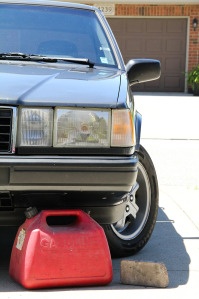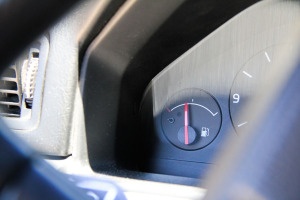 59 MPG highway, 48 MPG city. If you can believe it, these are the rated fuel economy numbers for the car I was driving on a flat, straight, stretch of highway. Even more unbelievable, it was not too difficult to match or even exceed the rated numbers. Just so we're on the right page, this was not a brand new hybrid car. No, this was a humble 2002 Honda Insight.
59 MPG highway, 48 MPG city. If you can believe it, these are the rated fuel economy numbers for the car I was driving on a flat, straight, stretch of highway. Even more unbelievable, it was not too difficult to match or even exceed the rated numbers. Just so we're on the right page, this was not a brand new hybrid car. No, this was a humble 2002 Honda Insight.
Driving this car is an experience everyone should have. Its a two-seater, all-aluminum hybrid car with a 5-speed manual. It has no power under the hood, but that's not the idea. The idea is to get you from point A to B with as little fuel as possible. Its so light you can feel exactly when your car hits the turbulence of a semi because the car starts shaking. When all was said and done, a full 10 gallon tank of premium powered us over 600 miles. In a car that was so effortless to achieve amazing fuel economy, it got me thinking. With a bit more effort, could I improve the fuel economy of my brick?
A 1991 Volvo 940 GLE is my daily steed. On a good day, it will get 25 MPG on the highway without trying too hard. I've read on the internet that some guys with just a small change in their driving style can improve their fuel economy by 5, 10 even more MPG. So if I read it on the internet it must be true.
I decided to embark on a personal challenge, to improve the fuel economy of my brick as much as possible over a 220 mile stretch of highway utilizing hypermiling techniques. Scouring the internet, I found the most reasonable methods by which I would use. I wasn't looking to bend the laws of physics or tape up all the panel gaps on my car. I was simply looking to see what I could do with my right foot.
The plan was to set the cruise control at 68 mph, as I found in the past that this was the sweet spot of my car. I would draft semi-trucks as much as possible, but not get too close that I would feel unsafe. Finally, I increased the pressures in my tires to around 36 PSI, all while modulating my right foot as smoothly and lightly as possible. To top it all off, I gave my car a good wash and wax to reduce that extra bit of drag.
 In short, hypermiling a brick was nothing to write home about. Staying as close to my prescribed speed as possible, making as few overtakes as I could and using a light foot netted me 26.8 MPG, a full 1.8 MPG better than my previous average. In the big scheme of things, this equated to 0.6 gallons of fuel saved or in today’s prices, $2.40.
In short, hypermiling a brick was nothing to write home about. Staying as close to my prescribed speed as possible, making as few overtakes as I could and using a light foot netted me 26.8 MPG, a full 1.8 MPG better than my previous average. In the big scheme of things, this equated to 0.6 gallons of fuel saved or in today’s prices, $2.40.
Was it worth it? Well, if you factor in the increased concentration needed to draft trucks, and the higher probability of damage to my car, I would say a solid no. But, if you take all of the negative away, don’t mind thinking a little bit harder for 4-hours, patching up your paint chips or replacing headlights and look purely at the fact that you’re $2.40 richer, then with a resounding yes, you can and you should hypermile your brick. With a trip to the dollar store for some duct tape for the panel gaps, I could probably save myself another $0.50 of fuel. That's worth it, right?
What's your best fuel saving technique?
 About the Author: Tim Wong
About the Author: Tim Wong
Tim is a Canadian from Windsor, and has plans to use his Volvo as an emergency space heater. He is a mechanical engineer by day and backyard mechanic by night. His mantra in life is to never break another bolt.











